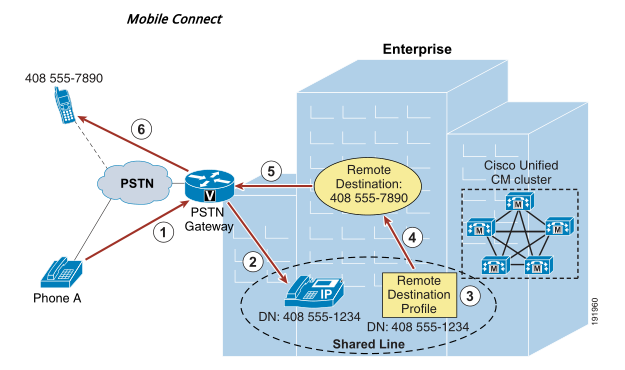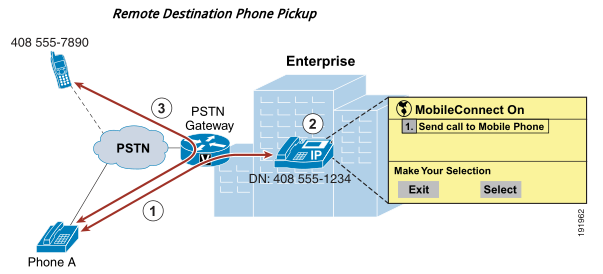- Cisco Community
- Technology and Support
- Collaboration
- Collaboration Knowledge Base
- Cisco Unified Mobility
- Subscribe to RSS Feed
- Mark as New
- Mark as Read
- Bookmark
- Subscribe
- Printer Friendly Page
- Report Inappropriate Content
- Subscribe to RSS Feed
- Mark as New
- Mark as Read
- Bookmark
- Subscribe
- Printer Friendly Page
- Report Inappropriate Content
12-28-2014 06:45 PM - edited 03-12-2019 10:13 AM
Introduction
This document covers the summary of Cisco Unified Mobility features and functionality.
Cisco Unified Mobility
Cisco Unified Mobility refers to the native mobility functionality within the Cisco Unified
Communications Manager (Unified CM) and includes the Mobile Connect, Mobile Voice Access, and Enterprise Feature Access features.

Cisco Unified Mobility Feature Summary
Unified Mobility provides the following features and functionality:
- Mobile Connect (also referred to as single number reach).
- Mobile Voice Access (MVA) – IVR based 2-stage dialing.
- Enterprise Feature Access (EFA) – Non-IVR based 2-stage dialing.
- Desk Phone and Remote Destination pickup – Active mobility call swap.
- Single Enterprise Voicemail Box – Timer-based mobile voice mail avoidance.
- Mid-call features (via DTMF feature access codes).
- Hold, Resume, Transfer, Conference, Directed Call Park
- Mobile Connect on/off toggle (via MVA, EFA, CUCM User Options pages, Desk phone* and CUMC client*).
- Time of Day Access Lists* – Allow or block call extension to configured Remote Destinations.
Mobile Connect
Incoming calls to user’s enterprise number rings both desk phone and configured Remote Destination(s)
- Call to mobile user’s Enterprise directory number rings at desk phone and Remote Destination phone.
- Call can be answered at either phone
- Once answered all other call legs are cleared
- Access Lists used to block calls from certain numbers
The Mobile Connect feature allows an incoming call to an enterprise user to be offered to the user's IP desk phone as well as up to 10 configurable remote destinations. Typically a user's remote destination is their mobile or cellular telephone. Once the call is offered to both the desktop and remote destination phone(s), the user can answer at any of those phones. Upon answering the call on one of the remote destination phones or on the IP desk phone, the user has the option to hand off or pick up the call on the other phone.

This figure illustrates a basic Mobile Connect call flow. In this example, Phone A on the PSTN calls a Mobile Connect user's enterprise directory number (DN) 408-555-1234 (step 1). The call comes into the enterprise PSTN gateway and is extended through Unified CM to the IP phone with DN 408-555-1234 (step 2), and this phone begins to ring. The call is also extended to the user’s Remote Destination Profile, which shares the same DN (step 3). In turn, a call is placed to the remote destination associated with the user's remote destination profile (in this case 408-555-7890) (step 4). The outgoing call to the remote destination is routed through the PSTN gateway (step 5). Finally the call rings at the remote destination PSTN phone with number 408 555-7890 (step 6). The call can then be answered at either phone.
Mobile Voice Access (MVA)
Mobile Voice Access (MVA) – Provides the ability to make calls from mobile phone using the enterprise IP telephony infrastructure
- IVR based application requiring H.323 or SIP* VXML gateway
- User can also enable/disable Mobile Connect
Benefits:
- Potential cost savings (e.g. international calls)
- Enterprise DN as caller ID (privacy, return calls)
- Centralized billing/call detail records for business calls
- Access to internal-only (non-DID) enterprise extensions
- Call Anchoring

This figure illustrates a Mobile Voice Access call flow. In this example, the Mobile Voice Access user
on PSTN phone 408 555-7890 dials the Mobile Voice Access enterprise DID DN 408-555-2345 (step 1).
The call comes into the enterprise PSTN H.323 or SIP gateway, which also serves as the VoiceXML
gateway. The user is prompted via IVR to enter their numeric user ID (followed by the # sign), PIN
number (followed by the # sign), and then a 1 to make a Mobile Voice Access call, followed by the phone
number they wish to reach. In this case, the user enters 9 1 972 555 3456 as the number they wish to
reach (followed by the # sign) (step 2).
Note
If the PSTN phone from which the Mobile Voice Access user is calling is configured as a Mobile
Connect remote destination for that user and the incoming caller ID can be matched against this remote
destination by Unified CM, the user does not have to enter their numeric user ID. Instead they will be
prompted to enter just the PIN number.
In the meantime, Unified CM has forwarded IVR prompts to the gateway, the gateway has played these
prompts to the user, and the gateway has collected user input including the numeric ID and PIN number
of the user. This information is forwarded to Unified CM for authentication and to generate the call to
9 1 972 555 3456 (step 3). After authenticating the user and receiving the number to be dialed,
Unified CM generates a call via the user's Remote Destination Profile (step 4). The outbound call to
972 555-3456 is routed via the PSTN gateway (step 5). Finally, the call rings at the PSTN destination
phone with number 972 555-3456 (step 6).
Enterprise Feature Access (EFA)
Enterprise Feature Access (EFA) Two-Stage Dialing – Provides identical functionality as MVA without the IVR component
Desk Phone/Remote Destination Pickup
Once incoming mobility call has been answered, call can be moved between desk phone and RD(s)
- Desk phone pickup: Hang up and resume, mid-call hold (*81) and resume, or mid-call session handoff * (*74) and answer.
- Remote destination pickup: Mobility softkey (‘Send call to mobile’) and answer.

As illustrated in this figure, once a user answers a Mobile Connect call at the remote destination
device (step 1: in this case, 408 555-7890), at any point the user can hang up the call at the remote
destination and pick it up again at their desk phone by simply pressing the Resume softkey on the desk
phone (step 2: at DN 408 555-1234 in this case). The call resumes between the original caller at
Phone A and the desk phone (step 3).

This figure illustrates Mobile Connect remote destination phone pickup functionality. Assuming
Phone A calls the Mobile Connect user's enterprise DN 408 555-1234 and the call is answered at the
user's desk phone and is in progress (step 1), the user must push the Mobility softkey. Assuming the
Mobile Connect feature is enabled for this phone and remote destination pickup is available, the user
presses the Select softkey (step 2). A call is generated to the user's remote destination phone (in this case,
408 555-7890), and the remote phone begins to ring. Once the call is answered at the remote phone, the
call resumes between Phone A and the Mobile Connect user's remote phone with number 408 555-7890
(step 3).
Mid-Call Features
Provides the ability to invoke enterprise features Hold, Resume, Transfer, Conference, Directed Call Park, and Session Handoff* from the RD/mobile phone for active mobility calls
Single Enterprise Voicemail Box
Single Enterprise Voicemail Box (mobile voicemail avoidance) – Per RD timers ensure that when mobility user is unavailable, unanswered incoming calls are forwarded to enterprise voicemail box rather than mobile or other voicemail box
Access Lists
Access Lists – Per RD access lists can be defined to filter or screen incoming calls to a mobility user based on caller ID. Filtering allows or blocks calls from being extended to the user’s RD. Time of day filtering* can also be applied.
Related Information
Find answers to your questions by entering keywords or phrases in the Search bar above. New here? Use these resources to familiarize yourself with the community: